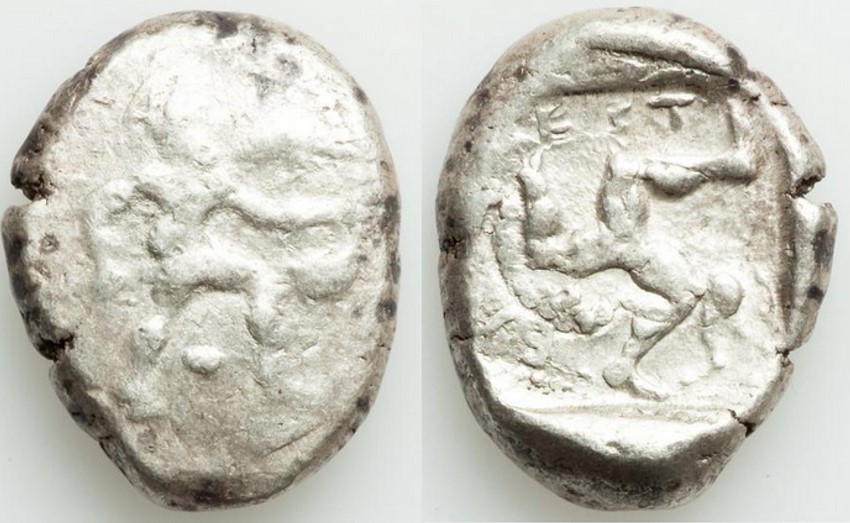2353 - Aspendus (double siglos hoplite/triskeles) over Tarsus (rider/archer) (Heritage, 231927, July 2019, 61059)
From SILVER
465 BCE - 430 BCE | ΕΣΤ
Images
Overstruck variety

Tarsus_archer_rider.jpg [1]
Location/history
| Sale(s)Sale(s) ᵖ: | Heritage Auction, 231927, 4 July 2019, 61059 | |
Overstriking coin
Description
| ObverseInscription or printing placed on the obverse.: | Warrior walking right, naked, wearing helmet, holding spear in right hand, shield attached on left arm. Between legs, pellet. | ReverseInscription or printing placed on the reverse.: | ΕΣΤ Triskeles of human legs. Behind, lion crouching left. All within incuse square. |
Mint and issuing power
| MintIdentifies the place of manufacture or issue of a numismatic object.: | Aspendus | Ancient regionAncient region. | Pamphylia | Modern countryModern country: Turkey | AuthorityIdentifies the issuing power. The authority can be "pretended" when the name or the portrait of X is on the coin but he/she was not the issuing power. It can also be "uncertain" when there is no mention of X on the coin but he/she was the issuing power according to the historical sources: | Persian Empire |
Chronology
| FromIdentifies the initial date in a range assigned in a numismatic context. 465 BCE toIdentifies the final date in a range assigned in a numismatic context.. 430 BCE | Classical 480-323 BC |
Physical description
| MetalThe physical material (usually metal) from which an object is made.: Silver |
WeightWeight of the numismatic object (in grams). in grams: 10.6610.66 g <br />10,660 mg <br /> | DenominationTerm indicating the value of a numismatic object. Examples: tetradrachm, chalkous, denarius.: double siglos |
|
| DiameterDescribes diameter of an object (in mm).: 2323 mm <br />2.3 cm <br /> | StandardStandard.: Persian | ||
References
| Coin referenceReference of the Coin: | Coin series referenceReference to coin series study: | Babelon 1901-19321Babelon 1901-1932, Tome 1, Part 2, p. 526-530, n° 869-70, SNG von Aulock Pamphylien2SNG von Aulock Pamphylien, n° 4482-3, SNG France 33SNG France 3, n° 12-13 | |
| Coin series web referenceCoin series web references: | |||
Overstruck type
Description
| ObverseInscription or printing placed on the obverse.: | Horseman (Syennesis?) riding to left, wearing kyrbasia, holding lotus flower in right hand and reins in left, bow in bowcase on saddle, Key symbol below horse, [Aramaic 'TRZ'] in exergue | ReverseInscription or printing placed on the reverse.: | Archer in kneeling-running stance to right, quiver over shoulder, drawing bow, Key symbol behind, all within dotted border within incuse square |
Mint and issuing power
| MintIdentifies the place of manufacture or issue of a numismatic object. ᵖ: | Tarsus | Ancient regionAncient region. ᵖ | Cilicia | Modern countryModern country: Turkey | AuthorityIdentifies the authority in whose name (explicitly or implicitly) a numismatic object was issued. ᵖ: | Persian Empire |
Chronology
| FromIdentifies the initial date in a range assigned in a numismatic context. 440 BCE toIdentifies the final date in a range assigned in a numismatic context.. 400 BCE | Classical 480-323 BC |
Physical description
| DenominationTerm indicating the value of a numismatic object. Examples: tetradrachm, chalkous, denarius. ᵖ: | double siglos |
References
| Coin type referenceReference to coin series study ᵖ: | |||
| Coin series web reference overstruckCoin series web references overstruck: | |||
Additional data
| Frequency of overstrikesFrequency of overstrikes: | frequent | Level of confidenceLevel of confidence of the identification: | weak |
| RemarksRemarks: | nb: the identification is problematic | ||
References
- ^ Babelon, Ernest (1901-1932), Traité des monnaies grecques et romaines, Paris, E. Leroux
- ^ Sylloge Nummorum Graecorum. Sammlung v. Aulock. Pamphylien. 11 Heft (n° 4477-4893), Berlin, 1965.
- ^ Levante, Edoardo [with the collaboration of Peter Weiss] (2001), Sylloge nummorum graecorum. France. 3, Département des monnaies, médailles et antiques : Pamphylie, Pisidie, Lyaconie, Galatie, Paris-Zürich, Bibliothèque nationale de France-Numismatica Ars Classica, XXXIV + 293 p. and 146 pl.
